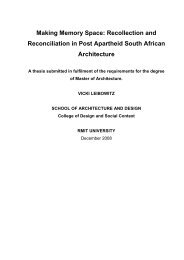Objects in Flux - RMIT Research Repository - RMIT University
Objects in Flux - RMIT Research Repository - RMIT University
Objects in Flux - RMIT Research Repository - RMIT University
You also want an ePaper? Increase the reach of your titles
YUMPU automatically turns print PDFs into web optimized ePapers that Google loves.
<strong>Objects</strong> <strong>in</strong> <strong>Flux</strong><br />
[Figure 4-2]<br />
Tim Hirzel’s Silvia coffee mach<strong>in</strong>e with<br />
Ardu<strong>in</strong>o controller, 2008.<br />
Photograph Hirzel.<br />
3/ http://www.ardu<strong>in</strong>o.cc/playground/<br />
Ma<strong>in</strong>/CoffeeTronics accessed 12 Feb-<br />
ruary 2010.<br />
4/ http://www.diyhappy.com/nes-<br />
controller-cellphone-mod/ accessed<br />
15 February 2010.<br />
5/ Figure A: ‘Pokia’ handset completed<br />
20 February 2005. UK designer Nicolas<br />
Roope co<strong>in</strong>ed the term ‘Pokia’ to de-<br />
scribe a traditional telephone handset<br />
connected to a mobile phone. Roope<br />
went on to market this product under<br />
the name Hulger, however the Pokia<br />
term persists with<strong>in</strong> the DIY commu-<br />
nity where <strong>in</strong>dividuals create their own<br />
versions. See for example Robert M.<br />
Hall’s home-made Pokia, http://www.<br />
54<br />
Tim’s coffee mach<strong>in</strong>e is no<br />
longer the basic product<br />
he purchased seven years<br />
ago. Tim has remade the<br />
mach<strong>in</strong>e’s <strong>in</strong>ternal function<strong>in</strong>g,<br />
user <strong>in</strong>terface<br />
and aesthetics – even its<br />
advertis<strong>in</strong>g narrative. He<br />
has also remade his role as<br />
‘owner’, ‘user’ and ‘consumer’.<br />
Tim has ga<strong>in</strong>ed<br />
possession of the object <strong>in</strong><br />
a way that far exceeds the<br />
generic forms of ‘ownership’<br />
and ‘use’ given with<br />
mass-produced consumer<br />
culture. The coffee mach<strong>in</strong>e has become a site of <strong>in</strong>novation, an arena<br />
through which Tim can extend his technical prowess and participate <strong>in</strong><br />
communal discourse.<br />
Tim’s actions, remarkable as they may be, are not isolated. His<br />
website l<strong>in</strong>ks to an onl<strong>in</strong>e community where numerous other coffee<br />
related modifications can be found. 3 In this network, <strong>in</strong>dividuals share<br />
their stories, offer advice and build collective knowledge. Such acts of<br />
modification and related activity are not limited to coffee mach<strong>in</strong>es:<br />
similar practices are visible <strong>in</strong> the ‘use’ of mobile phones (see, for<br />
<strong>in</strong>stance: NES controller mobile phone, 4 Pokia mobile handset, 5 SMS<br />
your VCR6 ), iPods (iPodL<strong>in</strong>ux, 7 Rockbox8 ), power tools (power tool<br />
drag rac<strong>in</strong>g9 ) and even vacuum cleaners (Roomba10 ). Collected under<br />
the terms ‘hack<strong>in</strong>g’, ‘modd<strong>in</strong>g’ and ‘DIY’, these practices of consumer<br />
modification present a diverse array of productive activity the scale<br />
of which has only recently become apparent.<br />
This chapter <strong>in</strong>vestigates the extent of these activities and their representation<br />
with<strong>in</strong> society via an exploration of the terms ‘hack<strong>in</strong>g’,<br />
‘modd<strong>in</strong>g’ and ‘DIY’. Through exam<strong>in</strong><strong>in</strong>g the emergence and use of<br />
these terms a general overview of practices of object modification is<br />
developed. This overview reveals a number of common themes that<br />
describe a highly social and transformative consumer practice.
















